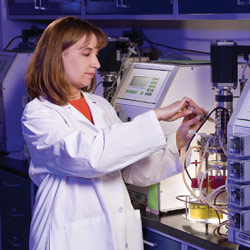
It’s been said that, “Innovation is the process of turning ideas into manufacturable and marketable form.” We hear a great deal about the beginning stage, the importance of creativity and ideas. We expect great fanfare in the result stage, as new products and companies are introduced into the market. What we don’t hear much about is how to engage the process of innovation that turns a rather abstract idea into a market reality. How does that happen? At NCAUR, the engagement usually begins with a relationship.
The following are some examples of significant new product innovations from NCAUR research that may not receive much notice beyond the industries they impact. Their existence is the result of a market need, expressed through a relationship and met through NCAUR research capacity.
New germplasm and antibodies
Mycotoxin research at NCAUR provides worldwide leadership in identifying the genetics of crop-damaging fungi responsible for producing toxins that are harmful to animals and people. The knowledge of NCAUR scientists has provided the basis for many of the genetic tools used in developing disease-resistant germplasm. Ongoing relationships and collaborations with major seed companies result in the innovation of new products taking the form of improved corn and wheat varieties. Additionally, that knowledge continues to be the basis for the innovative development of new antibodies used commercially in numerous toxin detection kits. In this case, the antibody is the new product that will be used to improve the toxin detection processes so important to the agricultural industry.
Specially engineered microbes
Fermentation biotechnology has been part of NCAUR research since before World War II and is another area of NCAUR scientific leadership. A significant challenge to the use of new source materials, such as switchgrass, for ethanol production is that most microbes cannot easily break down the new materials into fermentable sugars. Here again, ongoing relationships and collaborations with ethanol producers result in the innovation of new products taking the form of specially engineered microbes. In this case, the engineered microbe is the new product that will be used to improve fermentation processes at the core of expanded biofuel production.
Plywood adhesives
The USDA Agricultural Research Service (ARS) does not patent all of its usable technologies. It may be more effective to transfer the technology into use by publication. As a rule, when the knowledge behind a new technology is made publicly available, there is no way to track the impact. A soy-based plywood adhesive is an exception to that rule and another example of engaging the innovation process through relationships. The market need was to replace animal blood protein in existing plywood glue formulas. This need was directed into research made possible by a relationship and subsequent trust agreement between the USDA ARS and the United Soybean Board and funded by the board as an intermediary between the NCAUR and industry collaborators. The resulting product was a soybean-flour-based adhesive that addressed concerns about animal blood’s limited supply and about health issues, and generated faster production at lower cost. The adhesive is now in commercial use by a major plywood manufacturer, and research has since expanded into a second generation to test the viability of even cheaper sources of soybean meal and corn germ in a different type of plywood adhesive.
Super-absorbent water management tool
An excellent example of second-generation innovation is one that has its roots in the 1970s invention Super Slurper. This starch-based, super-absorbent technology was developed at NCAUR and resulted in commercial applications across multiple industries. Two entrepreneurs with chemistry backgrounds became interested in the original technology for a specific agricultural application. However, the first generation of Super Slurper was not suitable for their idea. Researchers at NCAUR worked closely with the two chemists to provide details of the original technology. That knowledge, along with use of NCAUR’s pilot plant facilities, formed the basis for a second-generation, super-absorbent technology and a new commercial product called Zeba. This biodegradable product, designed to store and release water in response to plant root suction, is usable as a water management tool with a variety of crops and is now marketed in 12 countries.
There is no storeroom at NCAUR of Next Big Ideas waiting to be commercialized. There is, however, a steady stream of significant innovations that benefit the agriculture industry and others flowing from relationships with NCAUR. Every relationship had to start somewhere—and all of these began with a conversation matching market need to NCAUR research capacity. iBi

